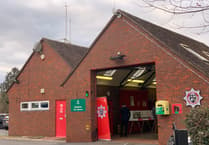We are accustomed to a few thunderstorms on warm summer days. Sometimes they are just a rumble of thunder far away, other times the sky is lit up by lightning and a big storm rolls in.
Woking witnessed a brief but violent storm on the morning of Sunday, June 30, 1907, in which a house in Boundary Road was badly damaged by a bolt of lightning.
In its issue of July 5, 1907, the News & Mail gave a detailed report.
Under the headline A terrific thunderstorm / House wrecked by lightning at Woking / Narrow escape of the occupier, the report said: “Woking was visited on Sunday by a violent thunderstorm, which, though of short duration, caused considerable damage, the upper storey of a house in Boundary Road being completely wrecked.
“The storm burst unexpectedly, and despite the distant rumbling that had been noticed, no-one anticipated a storm of such severity.
“Rain began to fall heavily, and then a blinding flash of lightning, accompanied almost at the same moment by a deafening peal of thunder, that shook the very roof timbers of the houses, came with startling effect.
“A few minutes later came a second flash and another ear-splitting crash, and directly afterwards the blowing of the fire hooter convinced all who heard it that some house or other had been struck by the lightning.
“This unhappily proved only too true, and though it did not lead to an outbreak of fire as was at first supposed, the damage done to property was very great, and one inmate of the premises narrowly escaped with his life.
“The house in question was a shop at the corner of Boundary Road and Omega Road, known as 13 Cecil Terrace, and was occupied by Mr Ryder, who, however, sublets the upper portion of the house to an elderly couple, named Puntis.
“About 11.30am, Mr Puntis was reading a newspaper opposite the open window in a small sitting room overlooking Omega Road, when he was almost blinded by a flash of lightning which seemed to whirl round the room and explode.
“The fire grate was blown in pieces from its setting, and a large piece of iron forming one side of the grate was hurled across the room, knocking a hole in the wall close to where Mr Puntis had been sitting.
“At the same time the ceiling seemed to bulge upwards, and Mr Puntis, with great presence of mind, raised a chair over his head for protection.
“It was only just in time, for immediately the plaster fell, and as Mr Puntis, who had suffered severe shock, staggered from the room and down the stairs, the landing ceiling also collapsed.
“At this point the story may well be taken up from the statement of an eye witness, Mr WJ Costa, of 16 Florence Terrace, Courtenay Road.
“He was standing in his garden gate looking for his children, who were out in the rain, when he saw the lightning strike the chimney of Mr Puntis’ house.
“The stack tumbled like a pack of cards. Then the roof was ripped up, and there was an avalanche of tiles into the street below.
“A cloud of dust and sulphurous smoke rose between the rafters, and it looked for all the world as if the house was on fire.
“That was what Mr Costa and others who saw the occurrence thought was the matter, and a neighbour immediately raced off on a bicycle to call the fire brigade.
“Mr Costa ran to the shop, and on entering the house found Mrs Puntis and Mrs Ryder terror-stricken in the kitchen.
“At the foot of the stairs, Mr Puntis lay huddled in a heap in an unconscious condition.
“Other help was immediately forthcoming, and medical aid was sent for.
“Drs Brown and Creasey were promptly in attendance, and under their care Mr Puntis, whom they found suffering from shock and burns on the arms, was brought to consciousness.
“Upstairs the scene was one of perfect wreck. The room in which Mr Puntis had been sitting was open to the sky, the floor was strewn with debris.
“The ceilings in other parts of the house had partly fallen, and in one room the paper was stripped from the walls.
“The furniture was damaged, and it is worth noting that a clock in the house stopped when the flash occurred.
“Despite the torrential rain that was falling, a large crowd quickly gathered round the premises, and many willing hands assisted to remove the furniture to a neighbouring house.
“The fire brigade turned out very promptly on receiving the call, but their services, of course, were not required, and they were able to return to the fire station.
“It was remarkably fortunate that no serious personal injury resulted from the collapse of the chimney and roof.
“Had anyone been passing the house at that moment, it is almost certain they would have met their death from the falling debris.
“Tiles were picked up at a considerable distance from the house, some being found on the common nearly 50 yards away.
“Mr Puntis, who is a decorative artist by profession, related his experiences to our representative on Monday.
“The old gentleman led the way up the stairs, which were covered with the debris, and on reaching the landing he turned into the room where the lightning entered.
“Pointing to a position opposite the fireplace, he said: ‘I was sitting here reading the paper about 11.40am, and glancing up I saw the ceiling moving upwards. I took hold of a chair and held it over my head. Then the roof fell in, and I rushed to the door. Just as I got outside, the landing roof fell. I never knew how I got downstairs; I must have thrown myself down. I must have been unconscious for a long time, for there were two doctors in attendance when I came to myself again.’
“He said that the lightning seemed to come down the chimney and burst, sending part of the ironwork of the fireplace across to the opposite wall, which was proof of the terrific force with which the debris was flung about.
“Asked if the house caught fire, Mr Puntis replied: ‘Not exactly. There was a kettle on the fire at the time the fireplace was smashed, and I think the water must have fallen on to the ashes, and put them out. In another room the paper is torn from the walls, and the lightning went through the floor and into the shop. My wife was downstairs, and my step-daughter, who lives with us, was at church. Most of our belongings are ruined. One of the clocks stopped exactly at 11.40am.’
“A fine cypress tree, some 70ft in height, standing in St John’s Churchyard, was destroyed by the lightning during the storm. The upper portion, nearly 40ft long, was cut clean off, and fell in an upright position, standing on the ground exactly as if it were growing.
“Another 20ft of the trunk was splintered, and huge blocks of wood, some of them weighing more than a hundredweight, were scattered for yards around.
“Only a few feet of the tree stump remained standing. So terrific was the shock, which occurred while morning service was in progress, that one or two panes of glass in the church windows were broken, and dust was shaken down from the rafters.”
Back in the heyday of picture postcards in the Edwardian era, the effects of storms and other disasters were quickly photographed and printed as postcards, which, not surprisingly, people eagerly sought.
It is fortunate the damaged house on the corner of Boundary Road and Omega Road was indeed photographed and postcards of it were issued.
The one featured here is in Peeps researcher Mark Coxhead’s collection.
It being a real photographic card is quite unusual as it is printed “in colour”, but that is to say it was artificially coloured in the printing process.
Thanks go to Mark, who found the report of the thunderstorm on the microfilm copies of the News & Mail at the Surrey History Centre in Woking.
Mark has also traced the Puntis family on the 1911 census that finds them then living in Walton Road, Woking.
Henry Puntis – who was 73 in 1907 – gave his occupation as house painter.
His wife Mary Puntis was 59 in 1907.
Step-daughter Puseilla Alice Asher, who was 18 in 1907, gave her occupation as book folder, working at a printers.




